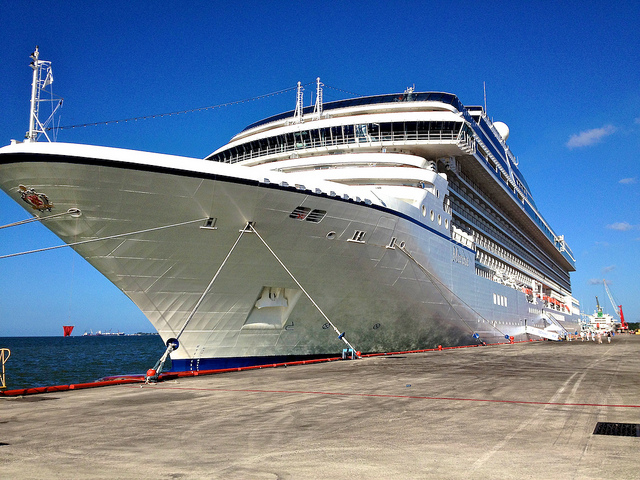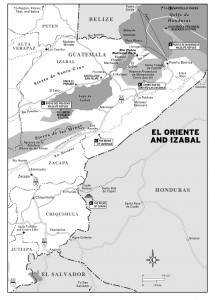
An Oceania cruise ship docked at Santo Tomás de Castilla. Photo © Victoria Herring, licensed Creative Commons Attribution.
Cruise ships dock in Santo Tomás de Castilla, just across the bay from Puerto Barrios, where those wishing to go ashore will find some of the country’s best bird-watching, lush tropical rainforests, and refreshing jungle rivers. Local tourism authorities in nearby Lívingston and Río Dulce are improving the quality of their services to cater to arriving visitors.The history of Santo Tomás de Castilla actually dates to 1604, when it was founded as the coast’s original colonial port. It was abandoned within a few years but later became the site of an ill-fated Belgian colony in 1843 after Guatemala’s independence from Spain.
A paved road from Puerto Barrios leads to the main shipping center. From there, a dirt road continues along the coast to some of the area’s natural attractions.

El Oriente and Izabal
This idyllic park, centered around the Cerro San Gil mountain, comprises more than 7,700 hectares (19,000 acres) of lush rainforest. Bathed in rainfall throughout most of the year (averaging 255 inches) as warm, humid air rises over the mountains from the sea to elevations in excess of 1,100 meters (3,900 feet), the preserve harbors an astounding level of biodiversity. Among the wildlife protected here are 56 species of mammals, including tapir and jaguars, 50 species of reptiles and amphibians, and more than 350 species of birds, including toucans, black and white hawk eagles, and keel-billed motmots. More than 90 neotropical migrants winter in the area and include the blue-winged warbler and wood thrush.
The park also protects the important watershed of the Río Las Escobas, which supplies water to Puerto Barrios. Part of the watershed is open to visitors ($8, including guided tour), who can bathe in Las Escobas’s cool, clear waters and hike a series of nature trails winding through the park. The park is administered by the private conservation group FUNDAECO (tel. 7948-4404), which in partnership with The Nature Conservancy has been able to buy large tracts of this rainforest ecosystem for preservation.
Facilities for visitors are found at Las Pozas (tel. 5708-0744 and 5004-1143, 9 a.m.-6 p.m. daily) and include a visitors center, tropical gardens, a snack bar (open on weekends and when cruise ships are in town), and picnic areas. An excellent system of trails winds through the river and waterfalls and includes wooden bridges with stops along the way for swimming in stunning turquoise pools. More adventurous types can explore areas deeper into the reserve beginning at a trailhead just up the mountain and going from there to the Río Las Escobas through a dense stretch of forest (one hour) or to Cumbre Las Torres (four hours there and back), or encompassing multiple days of strenuous jungle hiking to the village of Carboneras (where there is a basic eco-lodge) and down the mountain to Río Dulce. Contact FUNDAECO if you wish to explore these options, as you will need prior authorization. A guided trek of either of the first two options costs $30 per person. Rates for the longer trip are negotiable.
The park is an increasingly popular day trip with cruise-ship passengers, many of whom reportedly state this to be their favorite stop after the crass commercialism of places such as Cancún and beaches that all pretty much look the same. The park lies just off the road, hugging the coastline from Puerto Santo Tomás de Castilla to the beach of Punta de Palma. Social Travel (based out of Amatique Bay Resort, tel. 7948-1836 or 4172-2104) provides trips to Cerro San Gil and Río Las Escobas departing from Puerto Barrios, Lívingston, or Río Dulce. Prices range from $60 per person (two-person minimum) for a half-day tour to $150 per person for a trip including a stay of two nights. They can also arrange day trips and overnight stays at the eco-lodge in Carboneras (from Río Dulce) for about the same price.
Farther along this same road is the 50-room Green Bay Hotel (tel. 7948-2361, $60 d room-only or $130 d all-inclusive), which was built far ahead of its time in the early 1990s but now seems perfectly situated to cater to cruise-ship day-trippers. The comfortable thatched-roof duplex bungalows are built into the side of a beautifully forested hillside near the water’s edge and have all the comforts, including air-conditioning, TV, private hot-water bathroom, and bay windows that look out to the jungle. Although the exteriors are thatched-roof, it’s really only for show, as the room interiors pretty much look like any standard modern hotel room. There is an airy, thatched-roof restaurant and bar overlooking the swimming pool and Bahía de Amatique. In addition to seafood, the restaurant serves international dishes including pasta, sandwiches, and grilled steaks. It’s a bit overpriced at about $8 for a basic pasta dish.
Out front is a dock from where you can book a tour of the bay or a motorboat transfer to Punta de Palma, Punta de Manabique, Lívingston, or Río Dulce. Otherwise, you can catch some rays on the lagoon-front beach or explore the waters in a kayak. Two small mangrove islets, known as the Cayos del Diablo, lie just off the coast. Mountain bikes are also available for rent and there’s a sandy beach volleyball court. As at most of Guatemala’s Caribbean beaches, the water here is not clear like that along the Yucatán Peninsula, but more emerald in color. It’s what the tourism promoters have called “a different Caribbean.”
The road continues north from here to the beaches of Punta de Palma, a popular weekend getaway for folks from Puerto Barrios and where a sliver of sand meets the Caribbean Sea. There are some refreshment stands but little else here. Although locals might try to talk it up, you’ll probably be very disappointed, as the Riviera Maya this is not. If you really want to hit the beach, there are some better options near Lívingston and across the bay at Punta de Manabique.
On the up side, there is at least one pleasant villa available for rent fronting its own private beach in Punta de Palma. Villa Weyu ($750 for three nights) has 4 bedrooms, all with private bathroom, and sleeps eight. It’s got a full kitchen and open-air living room fronting the house’s infinity-edge swimming pool. It makes a nice secluded getaway or a good base for area explorations. The rental fee includes a cook and maid service.
Excerpted from the Fourth Edition of Moon Guatemala.